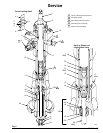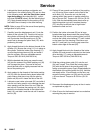20 308017
Service
6. Lubricate the throat packings and glands, and
install them in the outlet housing (10) one at a time
in the following order, with the lips of the v-pack-
ings facing down: the male gland (6{), v-pack-
ings (see the NOTE below), and the female gland
(4{). Apply thread lubricant to the packing nut (2)
and install the nut loosely in the outlet housing.
NOTE: Refer to page 32 for the correct throat packing
configuration for your pump.
7. Carefully insert the displacement rod (1) into the
bottom of the cylinder (12). Push the rod up into
the cylinder and through the outlet housing (10),
until it protrudes from the packing nut (2). Be
careful not to damage the piston seal (15*) while
performing this step.
8. Apply thread lubricant to the bottom threads of the
cylinder (12). Be sure the o-ring (11*) is in place on
the cylinder. Guide the intake valve housing (17)
up onto the priming piston rod (24) and screw it
onto the cylinder, using an adjustable wrench.
Torque to 325–354 N.m (240–260 ft-lb).
9. With the beveled side facing up, press the seal
(42) into the recess of the intake packing nut (18)
until it snaps into place. The nose of the seal
should be flush with or slightly recessed into the
face of the packing nut.
10. Apply sealant to the threads of the intake packing
nut (18). With the threads facing down toward the
pump intake, slide the nut up onto the priming
piston rod (24) until it clears the flats of the rod.
11. Lubricate a new intake valve seal (20*) and slide it
onto the rod, being careful not to damage the seal
when passing over the flats of the rod. Slide the
seal up until it reaches the packing nut (18). Apply
sealant to the female threads of the intake valve
body (19), and slide it onto the rod until it reaches
the nut (18).
12. Place a 26 mm wrench on the flats of the packing
nut (18) and a 28 mm wrench on the flats of the
valve body (19). Screw the nut into the body,
making certain they remain in position above the
flats of the rod (24). Torque to 45–53 N.m (33–39
ft-lb). Slide the assembled intake check valve up
the priming piston rod until it reaches the stop
(FF); this may be difficult due to high friction
between the seal and rod.
13. Position the intake valve seat (22) so its large
beveled side faces down toward the pump intake.
Slide the seat (22) onto the priming piston rod (24)
and into the intake valve housing (17) until it seats
on the lower lip of the housing. Lubricate a new
seal (21*) and push it up into the gap around the
bottom outer edge of the seat (22).
14. Apply thread lubricant to the threads of the intake
cylinder (23) and screw the cylinder into the intake
valve housing (17), using an adjustable wrench.
Torque to 325–354 N.m (240–260 ft-lb).
15. Slide the priming piston guide (31) onto the rod
(24) until it stops. Then install the priming piston
(25) with the flat side of the priming piston (25)
facing up toward the pump. Apply thread sealant to
the threads of the priming piston rod (24). Hold the
rod steady with a 12 mm wrench on the flats, and
screw the priming piston nut (30) onto the rod with
a 22 mm wrench. Torque to 45–53 N.m (33–39
ft-lb).
16. Reconnect the displacement pump to the air motor
as explained on page 15.
17. Allow 2 hours for the thread sealant to cure before
returning the pump to service.


















